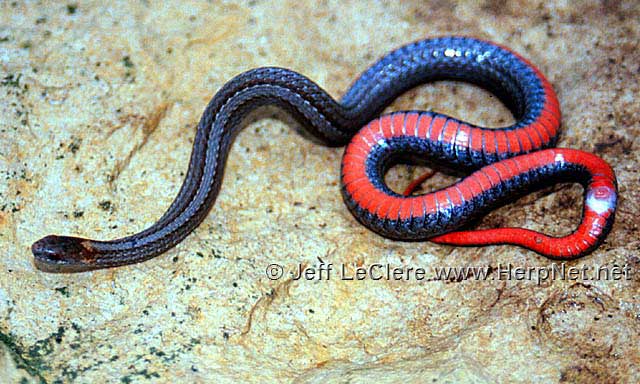Redbelly Snake (Storeria occipitomaculata)
Alternate names: Red-Bellied Snake
by Jeff LeClere



Status
PROTECTED and Species of Greatest Conservation Need. It is illegal to kill or collect this species by law in Iowa. Redbelly snakes are common but secretive in Iowa.
Description
Harmless to humans. This is Iowa’s smallest species of snake measuring 7 – 10 inches long (Conant and Collins, 1991). Generally speaking, there are two color phases of this snake and even these are subject to variation. One phase is dark brown to light tan dorsally with a single light mid dorsal stripe. The other phase is a shade of gray dorsally with four black or rust red stripes running lengthwise down the snake.
The following characteristics are shared by both: the belly is usually bright red or pink with no markings. There may or may not be three pale spots on the nape. The scales are keeled and the anal plate is divided. The bright red belly with no markings and the presence of dorsal striping is sufficient to distinguish it from other small Iowa snakes.
Subspecies
No subspecies are currently recognized. There were formerly two subspecies supposedly occurring in Iowa, the northern redbelly snake, Storeria occipitomaculata occipitomaculata, and the Black Hills redbelly snake, Storeria occipitomaculata pahapsae.
Range
The redbelly snake snake seems to occur through out the northeastern half of Iowa.

Habitat
This snake is generally considered a woodland snake, but it is also found in dry sandy habitats. It is often found near marshes, lakes, or other water sources.
Habits
This small snake may be found under flat objects or crawling across woodland trails in the evening or at night. Sometimes they may be found in garages or while moving a woodpile. Great numbers of these snakes are seen in the fall as they migrate to their hibernacula. They make no attempt to bite when handled, but they may release musk which is relatively mild compared to other species of snakes. The redbelly snake is secretive and their main defense from predators is hiding under rocks, logs or leaf litter. They overwinter underground in rock crevices, abandoned ant mounds, and in burrows dug by other animals. They breed in spring. Five to eight young are born alive in late summer and are very small, only 3 1/2 inches long.
Food
The redbelly snake eats slugs, snails, earthworms, and insect larvae. It is usually very difficult to get these snakes to consume anything other than slugs and snails without using scent-transfer techniques.